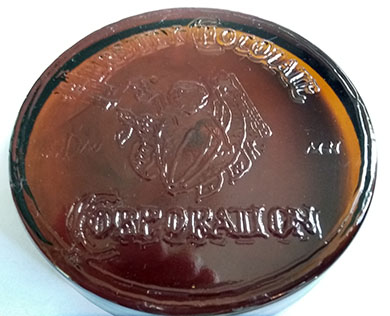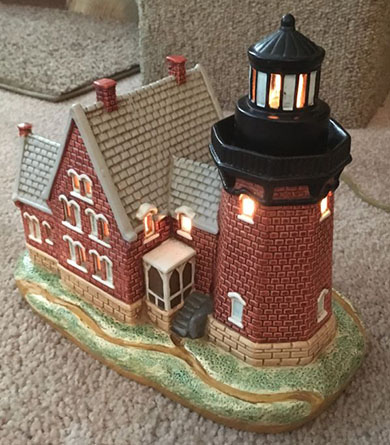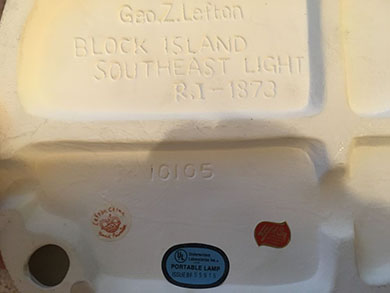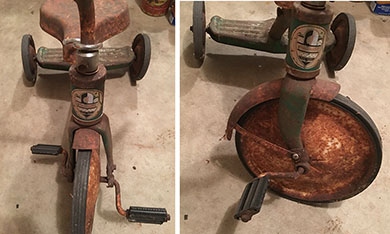 |
|
|||
 |
 |
|||
RINKER ON COLLECTIBLES — Column #1705 Copyright © Harry Rinker, LLC 2019 Questions
and Answers
QUESTION: About 10 years ago, I paid $12.00 for a dark brown glass, 3 3/4-inch in diameter, 1-inch thick paperweight that weighs 18 ounces. “HERSHEY CHOCOLATES” is in an arch at the top above the Hershey baby-and-cocoa bean trademark. To the left of the trademark is a relief image of the plant above a monogram consisting of a small “G,” a large “D,” and a small “W.” “MH” is to the right of the trademark. I assume it stands for Milton Hershey. “CORPORATION” in a fancy script is beneath the logo. When was this made and what is its value? – BR, Richfield, MN, E-mail Question 
ANSWER: After a frustrating half hour trying to find a direct match for your paperweight using Google, eBay, and WorthPoint.com, I did the obvious. I called the Hersey Archives and left a phone message in which I described the paperweight and requested a call back. Within a few hours, I receive a call from Jennifer Henderson, Senior Archivist at the Hershey Community Archives. At her request, I forwarded a copy of BR’s email. The next day I received an email from Jennifer that read: “I spoke with The Hershey Story Museum collections manager about the paperweight. The museum handles the 3-D objects while the Archives deals primarily with paper-based materials. “Neither the Museum nor the Archives has anything like this in its collections. The paperweight has ‘Hershey Chocolate Corporation,’ which the chocolate company used as its name from 1927-1968. The ‘baby-and-the bean’ logo is trademarked by The Hershey Company and was an early image used…on packing and promotional materials (c.1894-1937) though it has been revived several times over the company’s history. Giving an exact date is tricky because the company often used ‘vintage’ logos on newer items. “We think the GDW logo is probably a maker’s mark for the glass maker….As for the ‘HM,’ we do not believe it would stand for “Milton Hershey.” He typically used all three initials: ‘MSH.’ In fact, contemporaries referred to him as “MS.”… “We suspect that this may have been given to employees upon retirement, but there is no evidence of this.” After my research, I dismissed two possibilities related to the Hershey brown glass paperweight’s origin. First, it was not a product sold in a gift shop at Chocolate World or Hershey Museum. Second, it is not a fantasy piece (a piece that did not exist historically). If either were true, there would be dozens of examples for sale on the internet. My first thought was that it was a special gift created (1) for board members, (2) for special visitors to the factory, or (3) as a memento of a key event, the least likely because of the absence of a date. Jennifer’s retirement idea is a probability but less likely. If true more of these paperweights would turn up in the secondary market. Dating the paperweight is fraught with difficulties. My first thought was post-1945, fueled by the possibility that “GDW” might stand for Degenhart Glass Works. However, Degenhart never used this designation. My best guess is the “GDW” is the person who engraved the mold or object used to create the mold. In the antiques and collectibles field, value is dependent on the known rather than the unknown. Collectors collect what they can document. When objects appear for which there is no secondary market documentation, collectors hesitate paying a high price in case the object does not turn out to be as scarce or what they think it to be. My heart favors $75.00 to $100.00. The realistic side of my mind favors $45.00 to $60.00. Trust whichever one you like. QUESTION: I own a Lefton Southeast Lighthouse, Block Island, Rhode Island figurine. An embossed tag reads “One of two lighthouses on the island, Southeast Lighthouse stands 201 ft. above sea level. The 2000 ton Gothic Revival structure was moved back 245 ft. to safety from the rapidly eroding Mohegan Bluffs.” The bottom contains several markings: “Geo. Z. Lefton / BLOCK ISLAND / SOUTHEAST LIGHT / R.I. – 1873” in one rectangle. “10105,” a Lefton China circular mark with “Hand Painted,” a UL Portable Lamp label, and a Lefton oval label in a second rectangle. When plugged in, the windows and light of the lighthouse light up. What is its history and value? – DH, Altoona, PA, Email Question 
ANSWER: Once an accomplished sportswear manufacturer in Hungary, George Zoltan Lefton immigrated to the United States in 1939. He founded the Lefton Company, initially a china distributor, in 1941 in Chicago. Following World War II, Lefton was one of the first American distributors to import ceramics from Japan. The Lefton Company introduced its Historic American Lighthouse Collection in 1991. Each piece was fully illuminated and hand painted. Each piece came with an embossed tag providing a condensed lighthouse history. The Lefton Company issued two other lighthouse series. The Lost Lights Collection, limited to 5,000 cold cast resin pieces, was launched in 2000. The second is a series of miniature lighthouses averaging approximately 6-inches tall. There are over 100 lighthouses in the miniature series. George Z. Lefton died in 1997. His company was sold in 2001. The company continues to make lighthouse themed items. Although a glut on the market, Lefton lighthouses continue to sell within a narrow price range of $17.50 to $25.00. WorthPoint.com lists over a dozen 2019 sales. 
QUESTION: I have a Hiawatha tricycle, not a bicycle. The tricycle is badly rusted. I am considering restoring it but cannot find any information about it on the internet. A friend told me you might be able to help. CC, Email Question ANSWER: Although you have a tricycle, the following information about Hiawatha bicycles will help identify the maker. Gambles Hardware stores sold Hiawatha bicycles from the 1930s through the 1970s. A variety of manufacturers produced these store brand bicycles – Cleveland Welding Corporation, Huffman Manufacturing, Murray Ohio, and Shelby Cycle Company. The key name on the list is Murray Ohio. Gamble-Skogmo, Inc. is a corporate conglomerate of retail stores and other businesses. It was headquartered in St. Louis Park, Minnesota. Boyhood friends Berlin Gamble and Philip Skogmo from Arthur, North Dakota purchased the Hudson-Essex automobile agency in Fergus Falls, Minnesota in 1920. After several business changes, they opened the first Gamble Auto Supply Store in 1925 in St. Cloud, Minnesota. Franchises followed. By 1939, 1,500 Gamble dealers operated 300 corporate stores in 24 states. Gamble-Skogmo went public in 1947. Philip Skogmo died in 1949. The company’s Tempo Stores division, a chain of discount shopping centers, was created in 1962. Gamble-Skogmo was sold to Wickes Corporation of California in 1980. Wickes filed for bankruptcy in 1982. The Murray Ohio Manufacturing Company, located in Cleveland, Ohio, was founded in 1919. Although best known among collectors for its pedal cars, Murray Ohio also produced bicycles and tricycles, some with their own brands and others with store brands such as Sears, Roebuck, and Co. After evaluating the photographs that accompanied your email, I concluded that the cost of restoration will far exceed the value of the finished product. If you desire to go forward with the restoration and need parts, consider acquiring lesser condition Hiawatha or Murray Ohio tricycles and pirating the parts. There is a much more practical solution, buy a Hiawatha tricycle on the secondary market that is in very good or better condition. Hiawatha tricycles do appear for sale on the internet and at bicycle shows. Prices for an example in very good condition range from $45.00 to $60.00. Some patience will be required. 
Harry L. Rinker welcomes questions from readers about
collectibles, those mass-produced items from the twentieth and twenty-first centuries.
Selected letters will be answered in this column.
Harry cannot provide personal answers.
Photos and other material submitted cannot be
returned.
Send your questions to: Rinker on Collectibles, 5955 Mill
Point Court SE, Kentwood, MI 49512.
You also can e-mail your questions to
harrylrinker@aol.com.
Only e-mails containing a full name and mailing address
will be considered.
|
||||